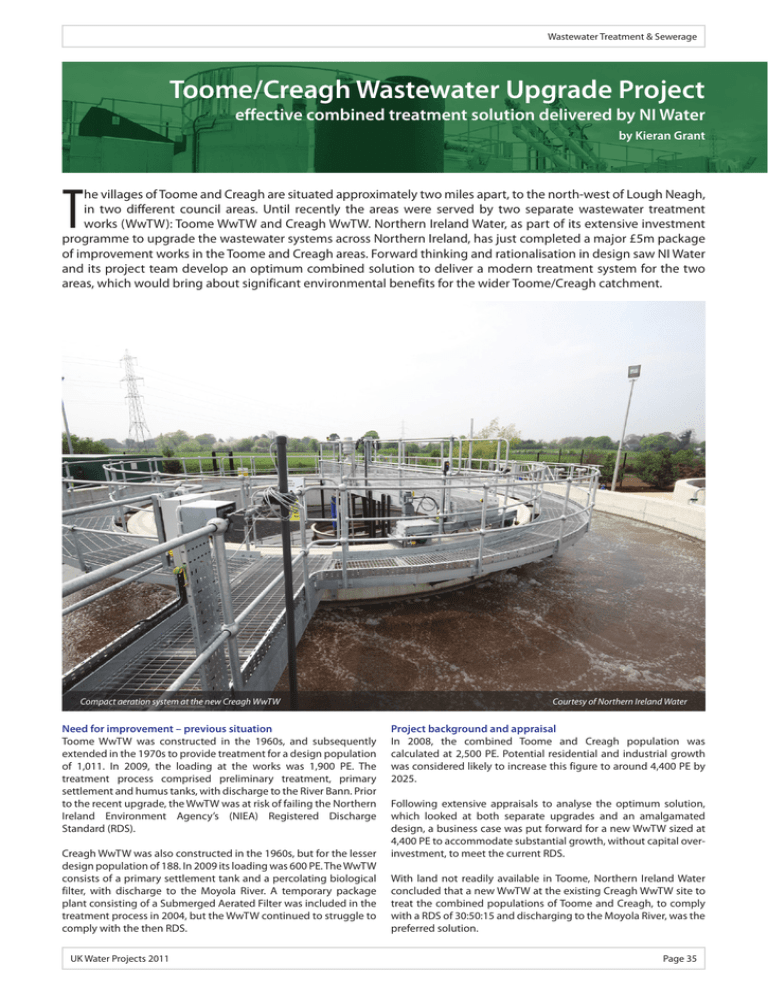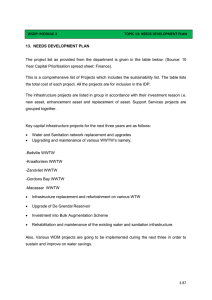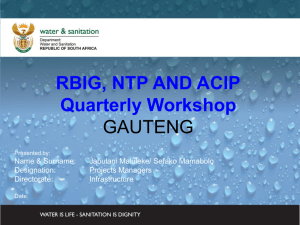
Wastewater Treatment & Sewerage
Toome/Creagh Wastewater Upgrade Project
effective combined treatment solution delivered by NI Water
by Kieran Grant
T
he villages of Toome and Creagh are situated approximately two miles apart, to the north-west of Lough Neagh,
in two different council areas. Until recently the areas were served by two separate wastewater treatment
works (WwTW): Toome WwTW and Creagh WwTW. Northern Ireland Water, as part of its extensive investment
programme to upgrade the wastewater systems across Northern Ireland, has just completed a major £5m package
of improvement works in the Toome and Creagh areas. Forward thinking and rationalisation in design saw NI Water
and its project team develop an optimum combined solution to deliver a modern treatment system for the two
areas, which would bring about significant environmental benefits for the wider Toome/Creagh catchment.
Compact aeration system at the new Creagh WwTW
Need for improvement – previous situation
Toome WwTW was constructed in the 1960s, and subsequently
extended in the 1970s to provide treatment for a design population
of 1,011. In 2009, the loading at the works was 1,900 PE. The
treatment process comprised preliminary treatment, primary
settlement and humus tanks, with discharge to the River Bann. Prior
to the recent upgrade, the WwTW was at risk of failing the Northern
Ireland Environment Agency’s (NIEA) Registered Discharge
Standard (RDS).
Creagh WwTW was also constructed in the 1960s, but for the lesser
design population of 188. In 2009 its loading was 600 PE. The WwTW
consists of a primary settlement tank and a percolating biological
filter, with discharge to the Moyola River. A temporary package
plant consisting of a Submerged Aerated Filter was included in the
treatment process in 2004, but the WwTW continued to struggle to
comply with the then RDS.
Courtesy of Northern Ireland Water
Project background and appraisal
In 2008, the combined Toome and Creagh population was
calculated at 2,500 PE. Potential residential and industrial growth
was considered likely to increase this figure to around 4,400 PE by
2025.
Following extensive appraisals to analyse the optimum solution,
which looked at both separate upgrades and an amalgamated
design, a business case was put forward for a new WwTW sized at
4,400 PE to accommodate substantial growth, without capital overinvestment, to meet the current RDS.
With land not readily available in Toome, Northern Ireland Water
concluded that a new WwTW at the existing Creagh WwTW site to
treat the combined populations of Toome and Creagh, to comply
with a RDS of 30:50:15 and discharging to the Moyola River, was the
preferred solution.
UK Water Projects 2011 Page 35
Focus
World leading expertise
dedicated solely to water
44%
MBR reduced energy
cost by 44% over the
previous WWT systems
$200k
Water industry
expertise prevents
complete factory
refurb, saving $200k
70%
New advanced water
reuse design helps
water-restricted business
expand by 70%
£90,000pa
Net savings achieved
through water reuse
Creating Value in Water
through innovation, creativity and expertise
Focus
70%
44%
$200k
£90,000pa
World leading expertise
dedicated solely to water
New advanced water
reuse design helps
water-restricted business
expand by 70%
MBR reduced energy
cost by 44% over the
previous WWT systems
Water industry
expertise prevents
complete factory
refurb, saving $200k
Net savings achieved
through water reuse
Experts in water - Ovivo is a single, global platform bringing together the world’s best expertise in water
including: Brackett Green® Copa®, Eimco Water Technologies® and Jones+Attwood.
info.uk@ovivowater.com
ovivowater.com
© Copyright 2011 GLV. All rights reserved.
Wastewater Treatment & Sewerage
Within the Creagh WwTW site, there was ample land space available
for both this solution and a future third stream. This availability
offered the opportunity for phasing, up to 2025 and beyond, to
accommodate growth - especially local government aspirations for
industrial expansion in the catchment.
All of the solutions considered for wastewater treatment in the
Toome/Creagh catchment would require modifications and
upgrade of the existing sewerage network. Flows would have to be
re-directed; new or upgraded pumping stations would have to be
undertaken and pumping mains and gravity sewers provided.
It was decided that the project would be carried out as two separate
contracts; (i) the construction of the new Creagh WwTw and (ii) the
upgrade of the Toome/Creagh sewerage network.
Toome Terminal prior to demolition
Courtesy of NI Water
Contract award
Creagh WwTW: Northern Ireland Water awarded the Contract
for the new Creagh WwTW to joint venture (JV) contractors
GEDA Construction and Ovivo. At the time, this experienced JV
was undertaking a similar wastewater treatment project for the
combined Bushmills/Portballintrae catchments.
NI Water had made provision in the Bushmills WwTW project
procurement process for an additional contract of similar nature,
and up to EU Threshold value, to be negotiated under the
competitive rates tendered within that Restricted List Procurement
Process. As such, Northern Ireland Water appointed GEDA-Ovivo JV
as the preferred bidder for the Toome/Creagh WwTW Contract via
the Bushmills WwTW Contract.
The old Creagh WwTW
Courtesy of NI Water
NI Water briefed GEDA-Ovivo JV to develop proposals with Activity
Schedule and Prices for Creagh WwTW under a Professional Services
Contract based on the Contract utilising the NEC 3 Option A (Priced
Contract with Activity Schedule).
Having the same project management and design team on board
for both projects delivered economies of scale, and allowed the
team to hit the ground running with the new Creagh WwTW in
November 2009.
Toome/Creagh Sewerage: For the Toome/Creagh sewerage network
upgrade, the four IWWF (Integrated Wastewater Framework)
Consortia were invited to tender. The GEDA-Ovivo JV was also
successful in this tender, which was awarded by Northern Ireland
Water in January 2010.
Project drivers
The following formed the principal project drivers for the entire
Toome/Creagh scheme:
The new compact aeration system
Courtesy of NI Water
Quality: Toome WwTW was at risk of failure, and Creagh WwTW
was already failing its RDS.
Growth: 60% population & industrial growth anticipated to
2017.
Compliance date: NI Environment Agency advised that Toome
& Creagh WwTWs should comply with the RDS by April 2012.
What the combined project entailed
The new combined solution called for reconfiguration of the
existing network so that all flows from the old Toome WwTW could
be conveyed to the new wastewater treatment works in Creagh,
before final discharge to the Moyola River.
View towards the new inlet works
Page 36
Courtesy of NI Water
In a complete overhaul of the existing systems, wastewater would
no longer be treated at the old Toome works, but would be
transferred along a new sewer network to the new treatment facility
at Creagh. The old WwTW at Toome was to be decommissioned
and refurbished as a terminal pumping station with additional
underground storm water storage provided at this site.
UK Water Projects 2011
Wastewater Treatment & Sewerage
The new treatment works at Creagh is designed as a conventional
Activated Sludge Plant (ASP) located on the site of the existing
works. With built-in flexibility, the new works has been designed to
the year 2025, to treat the increasing flows and loads. It currently
treats a population of approximately 2,500 PE but is capable of
treating a future population of 4,400 PE.
In addition to the modern new wastewater treatment works at
Creagh, the multi-million pound project involved the following:
•
•
•
•
•
•
•
•
•
•
•
Construction of the Toome Terminal Sewage Pumping
Station (SPS) and storm storage facility (previously the site
of the old Toome WwTW).
Toome Terminal SPS included foul and storm pumps,
screening and standby generator.
Gravity overflow from Toome Terminal SPS to River Bann.
New 600mm dia tunnelled gravity sewer from Main Street
SPS, Toome, to Toome Terminal SPS.
Small diameter gravity sewer rationalisation along Main
Street in Toome village.
Demolition of existing Toome WwTW.
180mm dia Toome pumping main onward to Creagh
WwTW.
Refurbishment/upgrade of Derrygarve SPS, and diversion
of Derrygarve pumping main directly to Creagh WwTW.
Refurbishment/upgrade of Blackpark SPS and a new 90mm
dia pumping main from Blackpark SPS to Creagh WwTW.
Refurbishment/upgrade of Hillhead SPS and 110mm dia
pumping main to Creagh Industrial Park SPS for onward
pumping to Creagh WwTW.
Refurbishment/upgrade of Creagh Industrial Park SPS and
new 180mm dia pumping main to Creagh WwTW.
Process description at Creagh WwTW
At the new Creagh WwTW, all sewage flows, which have been
pumped from the new Toome Terminal SPS, Derrygarve SPS,
Blackpark SPS and Creagh Industrial Park SPS enter a new inlet
attenuation chamber complete with stone trap. The works has been
designed to accommodate a Formula ‘A’ flow of 23.26l/sec.
Inlet works, screening and grit & grease removal
As the Formula ‘A’ flows and FFT flows are similar i.e. 23.26l/sec and
22.04l/sec respectively, there is no requirement for storm tanks.
The formula ‘A’ flow passes forward to secondary treatment. The
new preliminary treatment plant comprises duty/standby 6mm
bi-directional screens, each with screening conditioning facilities
and a grit and grease removal unit capable of handling flows up to
Formula ‘A’ flow (23.26l/s).
New anoxic selectors have been incorporated into the design,
which have four individual sectors complete with mixers and
bypass facilities, providing a combined volume of 200m3 capacity.
The settled sewage combines with the Return Activated Sludge
from the activated sludge process; the influent flows into a new
conventional activated sludge plant, comprising of twin circular
outer lanes and inner final settlement tanks.
The aeration lanes, in conjunction with the FSTs, are capable of
operating at elevated mixed liquor concentrations due to varying
volume facilities - such that when one lane is out of service for
extended periods, it does not compromise the effluent consent
standard. Adjustable bell mouths in the ASP can be used to vary
volume in the tanks to optimise loading requirements at the works.
Mixed liquor from the aeration tanks (each 17.3m dia with 4.5m high
walls) flows to the new inner final settlement tanks (each 8.5m dia
with 3.0m high walls) by means of weirs. Sludge blanket detectors
are provided for each final settlement tank for alarm purposes.
Sympathetic design & construction
NI Water and its contract team worked closely with planners,
architects, engineers and landscape experts to develop visuallypleasing low-impact designs that blend with the natural character
of the landscape. The new wastewater treatment facility was
constructed entirely within the confines of the existing site
perimeter and the buildings are in kiosk-type form to comply with
current planning regulations.
Both the Creagh and Toome sites have been landscaped with a belt
of native trees and shrubs, mainly deciduous species suited to the
Courtesy of Northern Ireland Water
UK Water Projects 2011 Page 37
Wastewater Treatment & Sewerage
waterside locations. The planting mix has been designed to require
minimum management with oak and pine as the “climax” species,
and a dense understory of native shrub species.
To promote sustainability, trenchless methods of pipe laying were
utilised where possible, and all spoil excavated on the Toome and
Creagh sites was reused in landscaping the areas around the new
WwTW and new Terminal SPS. Final effluent from the WwTW plant
is reused as washwater during the treatment process, for screen
washing and sludge thickening.
Challenges
Apart from the need to design and construct a wastewater
treatment works that would be accepted in a lowland area on the
shores of Lough Neagh, the biggest challenge for the team has been
to construct a modern new works whilst maintaining operations at
the existing plant on the same site.
All construction work on Creagh WwTW site, and at the various
sewage pumping stations, had to be completed in their entirety
and commissioned simultaneously so as to permit a single
commissioning start up. This was achieved through agreed phasing
and proactive programming. During construction, no relaxation in
discharge consent standards was permitted, and therefore it was
imperative to maintain high quality standards to the Moyola River
for final effluent and construction groundwater.
NI Water and the GEDA-Ovivo JV, developed a robust Environmental
Management Plan to meet NIEA requirements for the contract,
which meant that all possible measures were undertaken to ensure
that the construction work did not adversely impact on the adjacent
Moyola River, the River Bann and/or other watercourses.
Community liaison
Considerable time and effort was afforded to public relations
associated with the project. Council presentations and information
days were convened to inform local residents, businesses and
elected representatives as to the scope of the project, its importance,
and, most importantly, how any likely impact would be managed.
Written updates were distributed regularly to local businesses in
Toome to keep them up to date with progress on pipe laying work
in the village, and letter drops were carried out to residents in both
the Toome and Creagh areas to keep them abreast of progress.
Ahead of any school holidays, updates included key safety
information to advise parents not to let their children play near, or
on, any construction sites, and all key milestones were covered by
all local media through a steady stream of project press releases.
Throughout the scheme the project management team also
worked closely with council representatives in both Antrim and
Magherafelt Councils, local community groups and DRD Roads
Service in the programming of works, and all possible measures
were undertaken to facilitate road users and the local community.
For example, in a bid to ease congestion during pipe laying in
Toome village, a tunnelling machine was employed to lay the new
600mm dia gravity sewer from Toome Main Street SPS (which was
later decommissioned) to the new Toome Terminal SPS.
To complete the project as quickly as possible, the team worked
throughout the July holidays (a 2-week period which forms the main
builders’ holidays in Northern Ireland). A fantastic rapport was built
up between the project management team and local businesses,
which ultimately helped to ensure a smooth 4-month construction
period for tunnelling in the village. The team supported local
businesses at every opportunity through the purchase of general
commodities and sourcing local labour and supplies.
Conclusion
Now complete, the new and refurbished infrastructure in Toome
and Creagh is delivering an improved level of service to the people
in the locality; the standard of discharge has been enhanced to
meet the latest European wastewater directives and industrial and
domestic growth in the area will be accommodated by the new
system until at least 2025.
The Editor & Publishers thank Kieran Grant, Senior Project Manager
with NI Water, for preparing the above article for publication.
View from grit & grease removal plant showing activated sludge process and main control centre
Page 38
Courtesy of Northern Ireland Water
UK Water Projects 2011
Motors | Automation | Energy | Transmission & Distribution | Coatings
We can’t predict the future
but we can see it coming.
Meeting the IE2 standard for motors is mandatory from
June 2011, WEG motors already exceed it. The IE3
standard won’t be enforced until 2015 but WEG already
produces Premium Efficiency IE3 Motors. No date has
been confirmed for the IE4 rating but you can already
choose a super efficient IE4 motor from WEG.
Being ahead of the game is what we call WEGnology…
If you want to get ahead, visit www.weg.net








